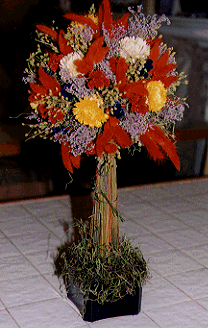|
Rittners School Of Floral Design
In Boston Presents.....
 Topiary Tree Clinic Topiary Tree Clinic
Hi There!! Welcome to our Topiary Tree Clinic!! This section came about by popular demand. Out of all of the email and requests that we have received from folks, I can't think of any that were more persistent than requests for topiaries.
We are not entirely surprised. Topiaries have been popular for a long, long time, but seem to have especially enjoyed a resurgence in recent years.
The concept of the topiary really has its origins in landscape and garden design going back centuries. The idea of trimming and forcing hedges into mazes and even different animal shapes has been a source of amusement, and pleasure for many a horticulturalist!!
From there it was but a short hop skip and jump to deriving floral based topiaries.
Floral art topiaries can all be analyzed in terms of three major component sections.......
- First of all, all topiaries are usually mounted in some sort of base. This base can be decorated with flowers, or left plain. But it is necessary for stability. Always take care to have sufficient weight on the base to cover the weight that will be suspended above it. And make sure your mechanics are covered (eg. via moss, foliage, etc.)
- Secondly, there is a top section or sections of a topiary. This can be shaped like a ball as shown in the illustrations in this section. But it could also consist of double balls, stars, hearts or any other shape you'd like. If you are using dried materials styrofoam will work well as a base into which you can place your flowers that have been placed on picks. If, on the other hand, you are using live materials in this upper section(s) you can either pick flowers into a styrofoam base (in which case your design will be relatively short lived --primarily for the occasion or event). Or you can use a foam top, in which case your flowers will be in a water base.
- Finally, all topiaries have some way of suspending the upper section(s) above the base. This can take the form of wooden, plastic, copper or any kind of linear material(s).
Check Out The Following Topiaries....
Down below are many examples of topiaries. They are all relatively easy to construct though they can be time consuming. Follow the steps delineated above.
The topiaries featured here can be divided into two types..dried and live...We have used similar contents in all of the dried topiaries and similar contents in all of the live designs. We have done this deliberately. It would be pretty easy to simply take different materials to make designs seem different. We want you to get a feel how you can start at about the same point with the same materials and still come up with variations in your designing.....
You can go down below and pick out the topiaries by number.
Alternatively, if you'd like to see smaller photos of all of the topiaries
in one spot, please click on
topiary thumbnails. Please be aware
that with a number of photographs this page may take a few minutes to download.
Click on the following:
We hope that you really enjoyed these brief floral design lessons. At
Rittners School of Floral Design
in Boston we provide floral design instruction that includes a wide range of different styles and techniques. Please come and take one of our hands-on workshop programs!!
Floral Education Center returns you to our Floral Education Center page with many other "How Tos."
Your Webmaster is Dr. Steve Rittner, who may be reached at Stevrt@tiac.net.
All photographs and text on this page are Copyright - Rittners School,
and may not be reproduced, or used for any commercial purposes.
|